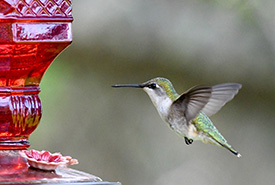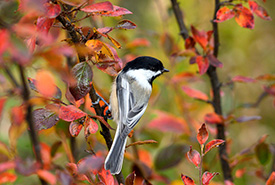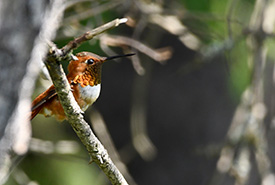Getting closer to nature, close to home

Hummingbird, Johnson's Mills, NB (Photo by Jordan Myles/NCC)
Backyard birding is one of my favourite ways to experience nature and develop an appreciation for urban wildlife. It's a hobby that not only brings me joy but also allows me to contribute to the conservation of avian species right in my own backyard. Backyard birding can be an accessible gateway to learning about bird diversity, land stewardship and connecting with nature.
There are many factors to consider when trying to attract birds to a feeder, and it is important to follow safe guidelines to ensure our interactions with birds are supporting avian conservation. When I first started birding, I was amazed by the variety of birds that could be attracted to a simple feeder with just a bit of knowledge about their feeding preferences and migration timing.
Where I live in Nova Scotia, some birds, like black-capped chickadees and nuthatches, stick around all year. Others, such as warblers and orioles, are only here during the warm summer months. One of my favourite aspects of birding is that it's a year-round activity, offering plenty of interesting sightings, even in the winter. During the colder months, providing feed can be a huge help to foraging birds, which need high-energy foods to maintain their body temperatures and survive. I make sure to offer a variety of foods, including high-quality seeds like sunflower seeds, which are loved by cardinals, chickadees, titmice and nuthatches, and peanuts to attract larger species like blue jays and woodpeckers.

Black-capped chickadee (Photo by Sean Feagan/NCC)
One of the most rewarding aspects of backyard birding is the opportunity to contribute to community science. Using apps like iNaturalist or eBird, I observe and document the birds I see, helping to contribute valuable data and build our understanding of bird populations and migrations.
Bird safety first
It's crucial to be responsible when putting out bird feeders and baths. Congregating groups of birds can lead to the spread of avian diseases and it is important to regularly clean feeders, bird baths and the area underneath them. Feeders should be cleaned every two weeks by scrubbing and soaking them in a bleach solution (one part bleach to nine parts water) and allowing the feeder to completely dry before refilling. Replace wet birdseed to avoid mold growth.
Nectar feeders are a great way to attract hummingbirds who will return year after year. I change the nectar regularly and clean the feeders with hot water and a clean bottle brush to prevent mould growth. Placement of feeders and baths is also important for the birds’ safety. I position them near natural cover to provide shelter from predators and ensure they are at least 10 metres away from buildings to avoid window collisions.

Rufous hummingbird, Johnson's Mills, NB (Photo by Jordan Myles/NCC)
The best way to attract birds to your backyard is by creating a bird-friendly habitat: avoid pesticides and plant native flowers, shrubs and tree species to bolster insect populations, which support birds during the summer.
It's incredibly rewarding to see how these efforts can have a positive benefit for wildlife and their habitats across the country. The Nature Conservancy of Canada encourages everyone, through Small Acts of Conservation, to help nature through collective small-scale actions. Click here to learn more about how you can make a difference for birds from near and far.
Backyard birding has enriched my life, and it's a hobby that not only allows me to connect with nature but also to contribute to the well-being of the birds that share our urban spaces. Whether it is in your backyard, a nearby park or simply on a walk in your neighbourhood, give birding a try and be amazed at the variety of species you can discover right outside your door.


